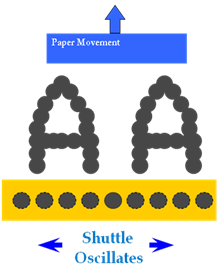Line printer
A line printer is a high-speed printer that does not put a line on paper sequentially like a print wheel printer , but in one fell swoop.
Working method
The different versions have in common that many types open more or less simultaneously at different columns of a line. In between there is either a ribbon or a colored cloth . However, they are still in use today for bulk orders, especially when carbon copies are required.
What they all have in common is the high level of work noise , which is why line printers are usually set up in separate rooms or with noise protection hoods.
history
The first IBM models had type bars or rods. All types of the character set (only capital letters, numbers and a few punctuation marks) were arranged on top of each other according to frequency, each printing column had its own. These poles were placed on the correct mark for each line and simultaneously struck for the entire line.
There were also drum printers that had a common roller with all printed characters per column, so that the hitting did not have to take place at the same time, but with individual hammers per column exactly when the continuously rotating roller was in the correct position.
In a certain sense, older cash registers and mechanical calculating machines are also line printers - here a type wheel with types on the cylinder surface, perpendicular to the paper, worked per column , which was rotated into the correct position before the line was printed .
The wedding of the line printer was its use as a peripheral to mainframes (Engl. Mainframes ) in the 1960s to the 1980s.
For smaller companies with high volume, there were matrix printers , which takes a moving along the entire line matrix printer had an oscillating by 1, 2 or 3 character widths horizontal needle comb -Druckkopfes - so-called shuttle matrix printer (see illustration). The matrix was implemented vertically using a pixel-by-pixel instead of a line-by-line paper feed. To a certain extent, these printers were even capable of graphics, were able to put different (variable) character sets on paper and mastered important font attributes .
Line printers have mostly been replaced by laser printers , which, in contrast, can print a whole page in one operation with (variable) font as well as lines and graphics (creation of forms) - and are also significantly quieter. However - carbon copies are not possible with them, which is why so-called "multiple originals" are used.
Construction types of current models
Today more developed representatives of the mechanical line printer are used. These are the drum or roller printer and the tape or chain printer . Either rollers or a chain with types rotate in front of the paper at very high speed in the printing yoke.
The print chain contains the complete or parts of the print mark set up to five times. For each column there is an electromagnetically operated hammer that strikes at the right time (usually from behind through the paper). The hammer blows for all characters in a line no longer occur exactly at the same time. The vertical paper transport takes place in a saccadic (jerky) manner and is only continued after the entire line has been completely processed.
Variable character sets or character widths (correspond to the print columns, standard are ten characters per inch with six (or "narrow" eight) lines per inch) were not possible with these machines. They were mainly used for printing on continuous paper .
